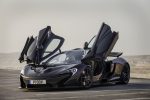
McLaren W1 is The Next Evolution in Hypercar Legacy as Successor to the P1
The world of hypercars is buzzing with excitement as McLaren confirms the name of its latest masterpiece: the McLaren W1. Set to debut on October 6, this reveal is timed to commemorate two historic milestones in McLaren’s storied Formula 1 history—the team’s first Constructors’ Championship win and Emerson Fittipaldi’s Drivers’ Championship triumph 50 years ago. The choice of “W1” reflects McLaren’s commitment to maintaining a world championship mindset, both on the racetrack and on the road.
A Decade in the Making for The Successor to the P1
It’s hard to believe that more than ten years have passed since the launch of the McLaren P1. As part of the “Holy Trinity” of hybrid hypercars alongside the Porsche 918 Spyder and Ferrari LaFerrari, the P1 was a technological tour de force, producing 903 horsepower from its twin-turbo V8 hybrid powertrain. With a lightweight carbon-fiber structure and cutting-edge active aerodynamics, it pushed performance limits in ways previously thought unattainable.
But McLaren isn’t content to rest on its laurels. The W1 aims to pick up where the P1 left off, blending innovation with performance. Earlier this year, McLaren gave dealers a sneak peek of the upcoming hypercar, code-named P18. While details are still scarce, we know it will feature a newly developed hybrid V8 engine, replacing the long-standing twin-turbo V8 that powered McLaren’s hypercars since the MP4-12C in 2011. This next-gen hybrid powertrain promises even greater power and efficiency, making the W1 a formidable contender in the hypercar space.
A New Design Language for a New Era
McLaren’s hypercar lineage is known for breaking new ground, not just in performance but also in design. The W1 will reportedly feature a fresh design language previewed earlier this year. Though the specifics of the car’s aesthetic are still under wraps, it’s clear that McLaren is aiming to deliver something visually stunning, a machine that captures the spirit of innovation while maintaining the brand’s signature aerodynamic efficiency.
A New Challenger in a Competitive Field
McLaren’s W1 is entering a hypercar arena that is rapidly evolving. Porsche is developing its own next-gen hypercar, an electric vehicle previewed by the Mission X, and Ferrari is cooking up a new hybrid hypercar. With both brands setting high expectations, McLaren has big shoes to fill if it hopes to maintain its place as one of the dominant names in high-performance automotive engineering.
But if history has taught us anything, it’s that McLaren has the capability to deliver vehicles that redefine what is possible, both on the road and the racetrack. Whether the W1 will capture the same legendary status as the P1 or the F1 before it remains to be seen, but one thing is certain: the world will be watching when the covers come off on October 6.
The W1 isn’t just about continuing a legacy—it’s about pushing the boundaries of what hypercars can achieve. As McLaren moves into this new phase of performance engineering, enthusiasts and industry insiders alike are eager to see how the brand will balance innovation with its racing heritage. McLaren has always thrived on exceeding expectations, and with the W1, it looks poised to do so once again.

